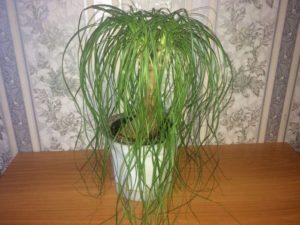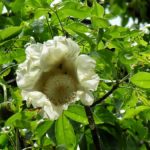Nolina
 The attention of visitors to botanical gardens is always attracted by large beautiful plants. There are many such giants in the agave family: yucca, cordilina, dracaena, nolin. All these plants grow not only in the wild, but are also used as decorative palm trees in office or home conditions.
The attention of visitors to botanical gardens is always attracted by large beautiful plants. There are many such giants in the agave family: yucca, cordilina, dracaena, nolin. All these plants grow not only in the wild, but are also used as decorative palm trees in office or home conditions.
An exotic tree-like plant of nolin, or in another way, has several different names at once: a sidear, an elephant leg, a bottle tree. The birthplace of the plant is Mexico and the south of the USA.
Nolina home care
In the wild, nolina grows 10 meters in height. In a closed room space, it grows to a maximum of 2 meters. The trunk of a tree is like a bottle: it is straight and has a bulge at the base in the form of a bulb in which, like in a tank, it accumulates moisture, which allows it to go without water for a long time. The structure of nolina bark resembles wrinkled elephant skin. It is because of these original features of the exterior that this plant is called a bottle tree or palm tree and even an elephant foot.
nolina bokarneya
Rigid, narrow leaves grow from the top of a tree like a horse’s tail. Old leaves bend and hang down at the base of the tree, while young leaves stretch up. Moreover, the leaves are so strong that Mexicans even weave hats and baskets from them. The lush crown of nolin, along with an unusual trunk, gives the plant a decorative and original look.
Nolina attracts gardeners due to its unpretentiousness and resistance to temperature extremes. At home, the plant is actually very comfortable, because the house does not have the sweltering heat of the day and the icy cold of the night. Nolina does not need regular watering and is not afraid of direct sunlight. Even in an apartment with dry air, being near heating radiators, nolina feels great. So care for nolina at home is completely not burdensome. But if the air in the apartment is too dry, you still need to spray the plant or sometimes give it a warm shower. Additionally, in terms of care, but this applies only to summer, it is better to make a light-loving plant on the balcony to provide it with an influx of fresh air. Lack of sunlight and excessive watering can lead to deformation of the tree trunk – it will stretch and become thinner.
A young plant needs to be replanted annually in the spring. An adult plant needs a transplant only as the roots get out of the flower pot, but at least once every 3, or even 4 years. When transplanting, it is necessary to carefully handle fragile roots, being careful not to damage them. The soil should be selected clay with the addition of sand, while providing the plant with good expanded clay drainage.



























